Lab-to-Lab: US-Russian Lab-to-Lab Collaboration Story [Archived]
Early Lab-to-Lab | Export Control | Nielsen Jr. | Symposia | WSSX
Physics | Reminiscences of Russia | Caroline (Cas) Mason
- Setting the Stage
- Forming Collaboration
- Frequent Experimental Campaigns Part 1
- Frequent Experimental Campaigns Part 2
- Broadening and Declining Collaboration
- Restoring Collaboration
- Epilogue 2006-2016
- Concluding Remarks
July 1989
My first trip to Russia was for participation in Megagauss-V, the Fifth International Conference on Megagauss Magnetic Field Generation and Related Topics. As discussed in Reference 1, the series of Megagauss conferences provided a forum throughout the Cold War for US-Russian dialog on magnetic flux-compression technology and applications, and essentially all of the initial LANL/VNIIEF collaborative topics that would be delineated in a June 1992 meeting were topics that historically fell under the megagauss conference umbrella.
My adventures in trying to secure visas and prepaid vouchers required for the trip will not be described in detail here. Suffice it to say, after having spent hours on the phone in Moscow, having taken a trip to Sheremetevo airport unaccompanied and having spent hours in back rooms of the airport’s freight terminal, I never did receive vouchers forwarded to me by a US travel agency—fortunately, the conference organizers were able to arrange for me continue my travel in spite of not having the vouchers normally needed.
On a post-conference tour in St. Petersburg, we overheard some teenagers speaking English. We were to learn that they were travelling with the Hugh O’Brien Youth Foundation. And, because O’Brien was travelling with them, I met face-to-face with a boyhood hero of mine who had played Wyatt Earp in the television series of the same name.
Describing my observations in a trip report, I wrote,
Because this was my first visit to the Soviet Union, I experienced for the first time the Soviet society and culture. For clearly irrational reasons, I entered the Soviet Union expecting a very different world. Because of my mindset … I had a rather strange feeling as I adjusted to the fact that … the people of the Soviet Union are like people in the United States.
Little did I know then that over the next two decades and more, I would learn even more just how much alike we are.
I also wrote “there were even suggestions of using Soviet DEMGs to drive US loads and that US scientists spend six months at a Soviet laboratory … the collaborative efforts should be actively pursued.” Little did any of us realize what the future held in store.
September 1991
Because I had interacted with Russian scientists from the Kurchatov Insitute in Moscow, most notably L. Rudakov, at international conferences, I had been invited to present lectures at the 2nd International Youth School on Plasma Physics and Controlled Fusion, which was to be held in Sochi, September 13-19, 1991. The attempted coup just a few weeks earlier had put the trip in jeopardy and it was only a few days before departure that the school organizers had confirmed that the school would be held as scheduled.
I was then on a LANL sabbatical to the Nuclear Engineering Department of Texas A&M University in College Station TX. Unfortunately, in spite of my frequent phone calls, many unanswered and unreturned, to Washington during the weeks prior to the trip, the US Department of Energy had not granted permission to travel right up until it was time to depart for the airport in Houston TX, some two hours away. At essentially the last moment before I would have to cancel my flight, I made contact with a person who told me “your trip has been approved … the last signature was obtained yesterday but I didn’t enter the approval into the computer until this morning because I had to go to a class.”
It was an eerie feeling as our small twin-engine YAK40 jet to Sochi took off from Moscow, climbing into cloud cover so heavy that all we could see as the “CCCP” on the wing tip. Recognizing that there was still a possibility of some unrest in Russia, my wife, Hedy, and I didn’t really know if anyone would know where to find us if turmoil erupted.
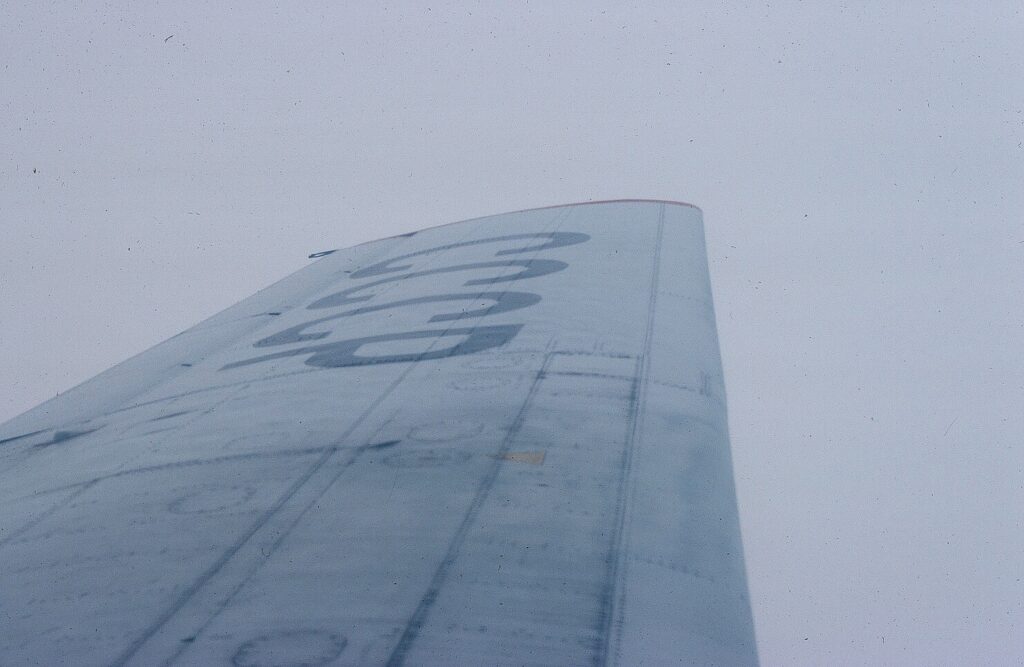
Fig.1. Looking out window as plane takes off from Moscow en route to Sochi (September 1991)
At the school it was obvious that most of the Russian participants were using the school as an opportunity to recover from the traumatic events in their country just a few weeks earlier. Several of the participants had taken to the streets in Moscow to protest.
When I had received the invitation to the School, I had attempted to make contact with V. K. Chernyshev, hoping to set up a visit to Sarov (or Arzamas-16 as we knew it then) as a follow-up to the discussions that had taken place in June at the IEEE Pulsed Power Conference in San Diego and in Los Alamos. Through sporadic communications before my US departure and during the School itself, a visit to VNIIEF appeared to be a distinct possibility even though, to my knowledge, the only previous western visitors to VNIIEF was the Joint Verification Experiment (JVE) team in 1989. Chernyshev had phoned me, and subsequently the School chairman in Sochi inquiring about the return schedule to Moscow. As I wrote in my trip report,
I was to find out … later that the return (to Moscow) schedule, coupled with our scheduled departure from Moscow the following day, made the security people at VNIIEF ‘very happy,’ for in their minds the schedule made it impossible for me to visit (VNIIEF).
Because I could not visit VNIIEF, Chernyshev, Vladislav Mokhov and several of his colleagues travelled to Moscow to meet me at my hotel near the Kurchatov Insitute upon my return to Moscow. Although we had studied papers authored by Mokhov, this was apparently the first time that an American had met him.
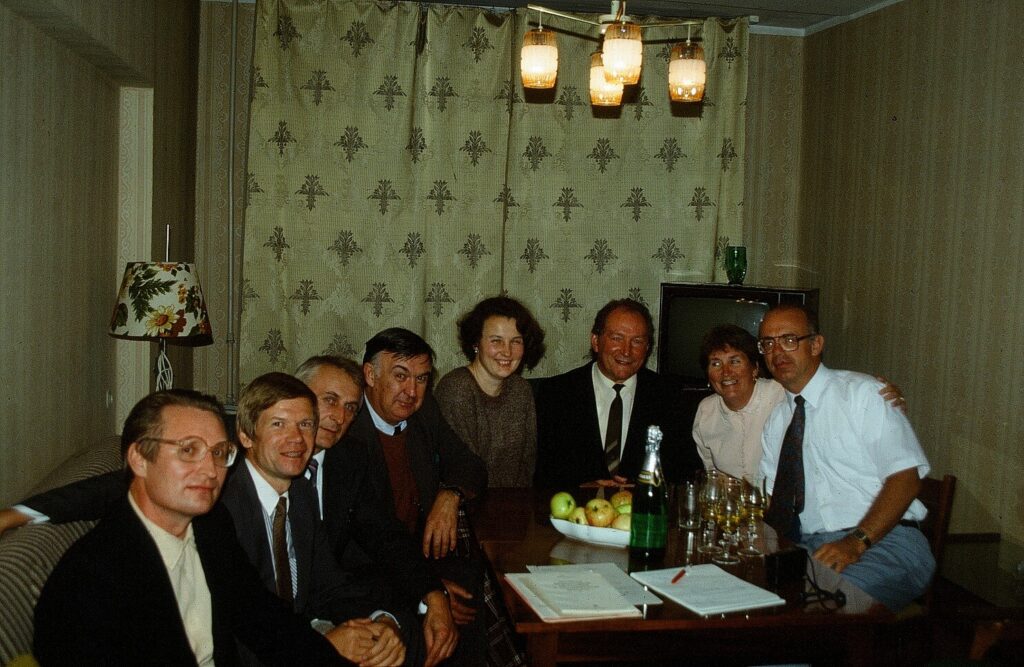
Fig. 2. Chernyshev-Mokhov team presents proposal for formal collaboration with LANL. Left-to-right: A. Petrukhin, S. Garanin, N. Bidylo, V. Mokhov, E. Panevkina, V. Chernyshev, Elisabeth (Hedy) Lindemuth, the author (Moscow, September 1991
To my surprise, the VNIIEF delegation delivered a formal written proposal for collaborative work with LANL. Details of this proposal and its impact are discussed in Ref. 1. In my trip report, I wrote,
Changes are occurring rapidly in the Soviet Union. If the US cannot keep up with these changes and respond rapidly, then the Soviets are likely to enter into agreements which are not consistent with US interests, e.g., collaboration with China on a technology which we believe has important military applications … That proposal … represents a potentially historic interaction between the two laboratories. Because of the people who made the proposal, because the proposal has the support of the Soviet government … that proposal should be given very careful consideration by the Laboratory and the US Government.
Little did we know then that the Soviet Union would dissolve abruptly in just a few months.
January, 1992
The first trip to Sarov for Bob Reinovsky and myself in January, 1992, was filled first with some apprehension because of the unsettled political situation in Russia. But the apprehension was overwhelmed by the excitement of learning more about VNIIEF’s fusion and flux compression efforts and with the recognition that we were playing a role in bringing the two institutes, and by implication the two nations, together.
As indicated in Ref. 1, prior to travelling to Sarov, we had attended the Zababakhin Scientific Talks that were sponsored by VNIIEF’s sister laboratory, the All-Russian Scientific Research Laboratory of Technical Physics (VNIITF). When our plane from the United States arrived at Moscow’s Sheremetevo II airport on January 12, we were greeted by VNIITF’s Boris Vodolaga, who would accompany us to Kistym, the location of the Zababakhin Talks. We were not on the ground very long before Vodolaga inquired about the relationship between LANL and LLNL. He said that he had been told that the relationship was “like this” as he pounded his clenched fists together. We smiled, then asked him about the relationship between VNIIEF and VNIITF. After a period of deep thought, Vodolaga repeated his clenched fists gesture.
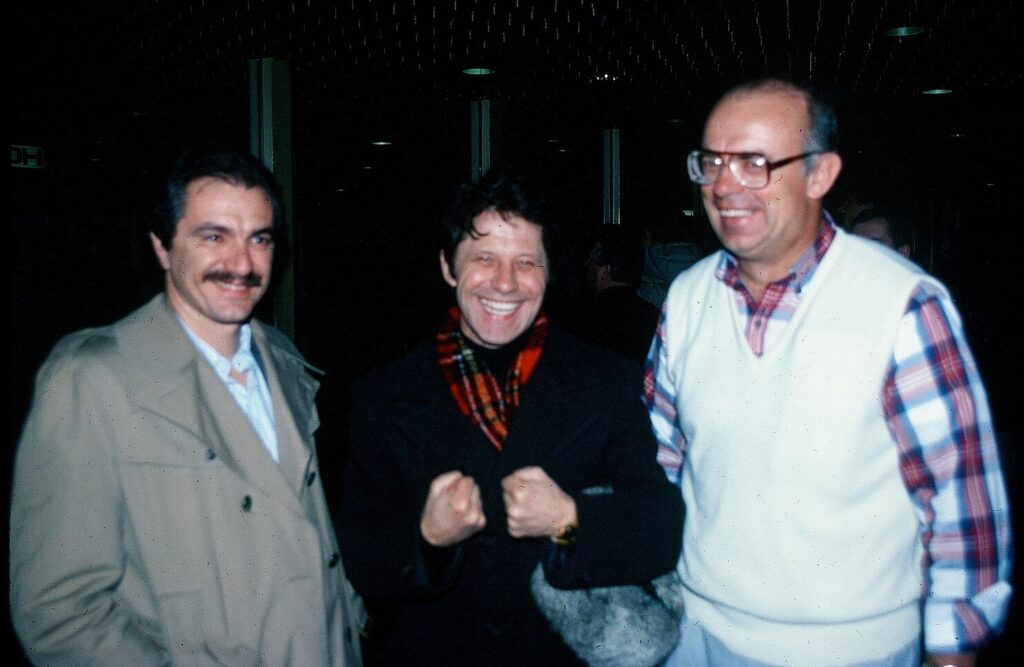
Fig.3. VNIITF’s Boris Vodolaga (center) explains the relationship between LLNL and LANL (and VNIIEF and VNIITF) to Alan Spero (LLNL; left) and Lindemuth (Moscow, January 1992).
At VNIIEF, I presented a formal seminar entitled “The Parameter Space of Magnetized Target Fusion” and Bob presented one entitled “Research Activities of the Shock Wave Physics Group at Los Alamos” to a large and curious audience in an auditorium in Chernyshev’s building behind VNIIEF’s security fences (Video fragment). When I had completed my seminar, Anatoli Demin asked “what has changed since your 1983 paper,” to which I had to answer that nothing much had changed; unfortunately, in spite of the exciting results of the 1983 paper, the U.S. chose to invest very little in any fusion approach except the mainline, well established conventional inertial and magnetic fusion approaches (See Ref. 1 for a discussion of the 1983 paper and the Unexpected Legacy of the collaboration).
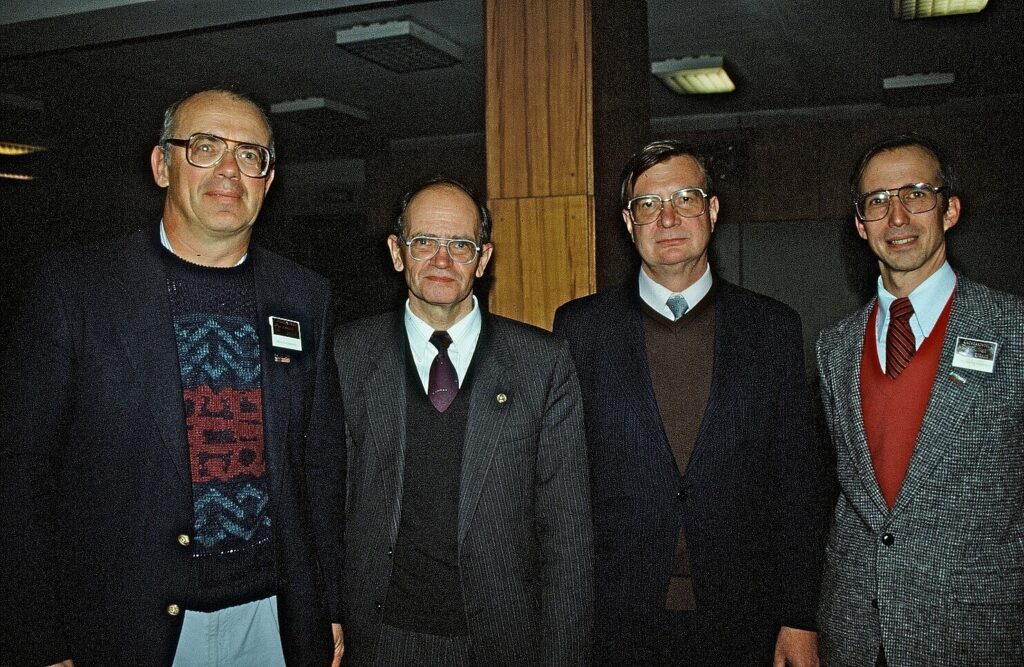
Fig.4. Lindemuth (l) and Bob Reinovsky (r) meet with VNIITF’s A. Avrorin and V. Nechay on behalf of LANL Director Sig Hecker to invite them to meet with US lab directors in the US (Kyshtym, January 1992)
One afternoon, we were taken to Sarov’s school #2, the “English-speaking” school, where we were introduced to Vladimir Chernyshev’s grandsons and Lena Gerdova’s (VNIIEF interpreter) daughters and where we had an opportunity to interact with a number of students. It is difficult to describe the emotions we felt as we met intelligent, healthy, and polite students and very dedicated (and strict) teachers in this country that we thought considered us to be enemies. We were told “even in these troubled times, the children are our privileged class.” As we asked ourselves why would they introduce us to their children, the only answer we could come up with was that we were being given a message that we all shared similar family values and a similar hope that our children could grow up in a safe and peaceful world.
This school visit set the stage for many future visits to Sarov schools by the LANL team who considered the visits to be among the most enjoyable social activities of the trips. Reciprocal visits to Los Alamos schools would occur when VNIIEF personnel visited Los Alamos, and these visits led to “pen pal” exchanges, with several hundred students from each city participating. It became commonplace for LANL scientists traveling to VNIIEF to carry numerous letters from the students of Los Alamos schools, and vice versa. The letter exchanges lead to Los Alamos and Sarov becoming Sister Cities.
At a closing banquet, the two of us, who were essentially tea-totallers (i.e., non-drinkers), found ourselves outnumbered about 10:1 by a cheerful group of vodka-drinking Russians who introduced us to the wonderful Russian tradition of offering toasts and who taught us our first Russian word. Noticing that we hardly sipped our vodka during toasts, our hosts good-naturedly spoke the word “chuit-chuit,” which evidently meant “a little bit.”
As we rode the train back to Moscow, accompanied by Chernyshev, Bidylo, and Gerdova, we were introduced to the Russian tradition of writing sentiments on the back of photographs. These captured the hopes that the visit had brought to all of us, and also showed that the shadow of Andre Sakharov was looming over us. Chernyshev wrote, “Let us try together to solve the problem [fusion] to which Andre Sakharov gave so much forces and his soul.” On a picture of us in front of Sakharov’s house, Bidylo wrote “Let this house which stays on Sarova land and the person who lived and worked in this house remind us that we choose the correct way of our activity.” I wrote, in part, “to predict where our mutual interests will lead us, of course, is impossible. Wherever it leads, we will share the satisfaction that we tried.”
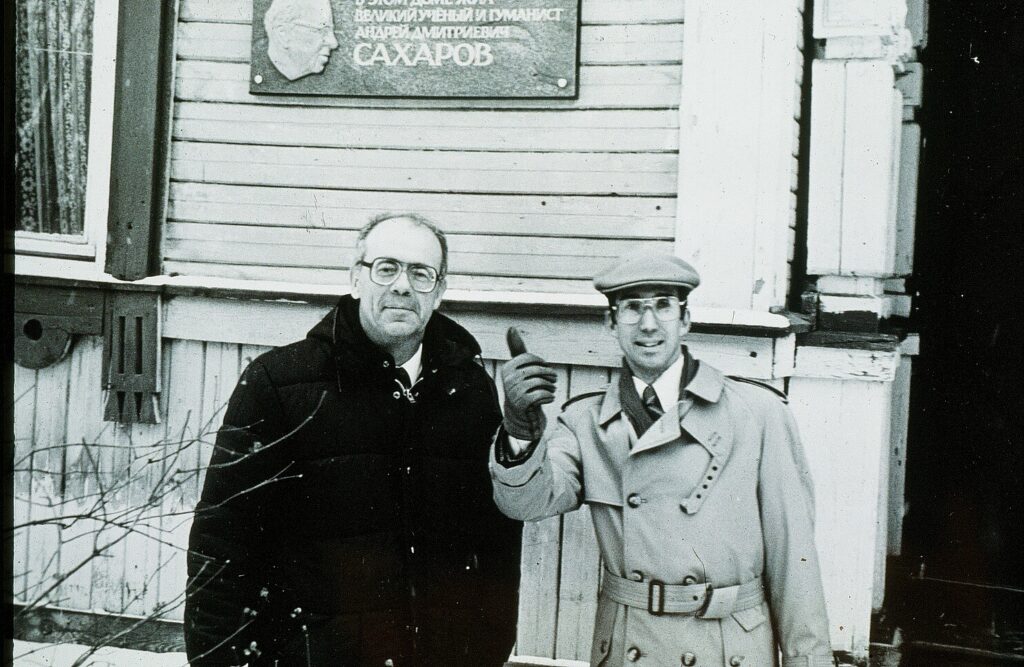
Fig.5. Lindemuth (l) and Reinovsky stand in front of the house once occupied by Nobel Peace Laureate Andrey D. Sakharov, who died just a few months after the Megagauss-V conference. We have always wondered what Sakharov would think of the LANL/VNIIEF collaboration (Sarov, January 1992).
When I returned home to College Station, Texas, where I was then a visiting professor of nuclear engineering at Texas A&M University on a year’s sabbatical leave from LANL, I discovered a small plaster figurine in my suitcase. Totally baffled at the figurine’s origin, I called Bob, who explained that figurines had been given to us at a Sarov art school. I had no memory whatsoever of the art school and had totally blanked out the visit, evidently due to a combination of jet-lag and the very emotional impact of the visit to school #2 that had preceded the visit to the art school.
After seeing poor quality presentation equipment and materials at the Zababahkin Talks, one of our recommendations upon our return was for the U.S. to send a “boxcar full of paper” and other equipment and materials to Russian scientists. Within a few years, we were able to provide our collaborators with computers and printers that had more capability than they had available at the time.
